|
Subscribe / Renew |
|
|
Contact Us |
|
| ► Subscribe to our Free Weekly Newsletter | |
| home | Welcome, sign in or click here to subscribe. | login |
Environment
| |
 Return to the Building Green Index Return to the Building Green Index |
February 18, 2010
A new use for urban high-rises: farming
Weber Thompson

Albert
|
That’s all changing, and a renaissance in urban agriculture is upon us. In an effort to bridge the gap between ecological buildings and food production, a new concept called vertical farming has the potential to revolutionize the way our cities function.
A broken system
A significant disconnect exists between the consumer and the producer. Foods are processed, often beyond recognition, and delivered in packaging designed to withstand an average of 1,500 miles from production to plate.
Agriculture consumes 80 percent of available fresh water and the resulting runoff is laden with pesticides and fertilizers that are eventually swept downstream, causing major environmental damage. Even organic practices can lead to the over-application of manure with similar results.
Further, global concerns including population growth, rapid climate change, food contamination, and the growing imbalance between the availability and distribution of food could be a recipe for disaster.
Simply put, the system is broken.

Image courtesy of Weber Thompson
Weber Thompson developed this conceptual design for Eco-Laboratory, a Belltown apartment building with a vertical farm. |
In light of this situation, many people are going back to the basics and growing their own food in an effort to consume a better product. Victory gardens, community gardens (P-Patches here in Seattle), community-supported agriculture programs are creeping into mainstream America and are a perfect example of at-home solutions. While these efforts are an important part of the food issue, there’s a much larger problem to be solved. How do our communities feed themselves in an environmentally sensitive, socially just and economically viable model?
Obviously the question has no one specific answer. A host of solutions are needed to address the complexities of bringing food to people. One initiative, designed to supplement the existing food supply while bringing more healthful products to our cities, is vertical farming.
The vertical farming concept is pretty simple. Grow food in a climate-controlled multistory building free of pollutants, pesticides and seasons while producing the highest-quality produce in an urban environment.
Sound like science fiction? Not quite. The term was originally coined by Dickson Despommier at Columbia University. He envisions buildings filled with stacked soil-less growing systems designed to produce the maximum yield and eliminate contamination. This concept has been illustrated by designs ranging from 10-story skyscrapers to dragonfly wing-inspired behemoths that tower over Manhattan.
Serving communities
Vertical farms uses three main methods for growing foods: drip irrigation, hydroponic and aeroponic systems. These technologies do not require traditional soil. Instead, they use a rooting medium to stabilize the plants while water or mist delivers nutrients.
Crop yield per square foot can drastically increase using these methods. Some systems boast increased yields by 200 to 300 times compared with conventional agriculture. Additionally, these systems use 80 percent to 95 percent less water.

Photo by Karam Puri Eric Haley, Jenn Nelkin and Viraj Puri, co-founders of Gotham Greens, are installing a greenhouse on this Brooklyn, N.Y., rooftop to supply produce to local Whole Foods stores. Gotham Greens could be a model for integrating commercial agriculture into cities. |
The variety of crops is endless, but most likely the first vertical farms would be limited to leafy greens, tomatoes, strawberries and peppers. Depending on the crop, they can be stacked one on top of the other, with multiple levels per floor filling the volume of the space. Stacking the floors inside a multistory building would just continue to increase the yield per square foot and thus the commercial viability of the farm.
Many proposals also address the needs of equitable distribution by locating these buildings in underutilized or underserved communities. The result would be to deliver a high-quality product to neighborhoods that otherwise would not have access to nutritious foods.
All this comes without the limitations of climate, seasons, droughts and availability of scarce resources such as water and land. In other words, vertical farms are not shackled by traditional agricultural considerations but are adaptive to the needs of the community where they are located.
Obstacles
Bringing this concept to reality is not without its challenges. For instance, energy consumption in a building using artificial lighting to grow food could be very high. Traditional grow lights use a lot of energy, give off excess heat and are an inefficient method for growing food.
In the near term, however, advancements in LED lighting technology can not only reduce the necessary energy, but can also target the light spectrums for the plants’ individual needs. Additionally, energy can come from renewable resources such as wind and solar, while not consuming the vast amounts of fossil fuels used in conventional agriculture.
The economic viability of vertical farms is also a great concern. Equipment, space, energy and distribution all have their associated cost.
Research needs to be done to balance the costs with the profitability of growing produce. Realistically, a research facility will be among the first pilot projects to test and perfect vertical farming. In doing so, risk can be reduced and help ensure the development of businesses that can perform successfully in the open market. These are the ultimate green jobs.
What’s happening now
While the vertical farming movement is still in its infancy, there are existing urban projects that contain the elements of indoor hydroponic agriculture.
Gotham Greens, a small New York-based startup, is installing a 10,000-square-foot greenhouse on a rooftop in Brooklyn. The produce grown will be distributed at Whole Foods Markets in the surrounding boroughs. This will be the first commercial project of its kind in the U.S., and could prove to be the model for integrating for-profit urban agriculture systems into cities.
Additionally, component manufacturers from across the globe are developing very exciting technologies that work within a vertical farm. One of these manufacturers, Valcent Products in the United Kingdom, has developed a prototype one-story growing system they’ve installed at a local zoo.
Although many of the conceptual designs for vertical farms found on Web sites and blogs border on the absurd, realistic site-specific solutions will undoubtedly emerge. Once these projects address the environmental, societal and economic implications, and a reasonable balance is met within this triple bottom line, it will then be possible to bring these structures into our urban centers.
If we are to solve the world’s food problems, we must pursue, test and evaluate creative thinking and solutions. Vertical farms are a new approach that could help us fix the current food production and delivery model. While not a silver bullet in and of itself, vertical farming provides a vision for a more healthful, sustainable and resilient city.
(Editor's note: This story has been changed to correct the location of Gotham Greens.)
Dan Albert is an ecological designer at Weber Thompson, where he helped develop the Eco-Laboratory, a self-sufficient living building concept that incorporates vertical farming in its program.
Other Stories:
- For a better green building, start with a simulation
- There’s more than one way to certify a green building
- Green homes outselling the rest of the market
- New product-safety tools put focus on building materials
- Tacoma housing project aims for LEED platinum
- 7 trends that will shape the future of green building
- 3 steps to put homeowners on path to energy efficiency
- African Americans and sustainability: It’s all about ‘making do’
- Green building technologies that could change the game
- Could poorly performing projects kill green building?


